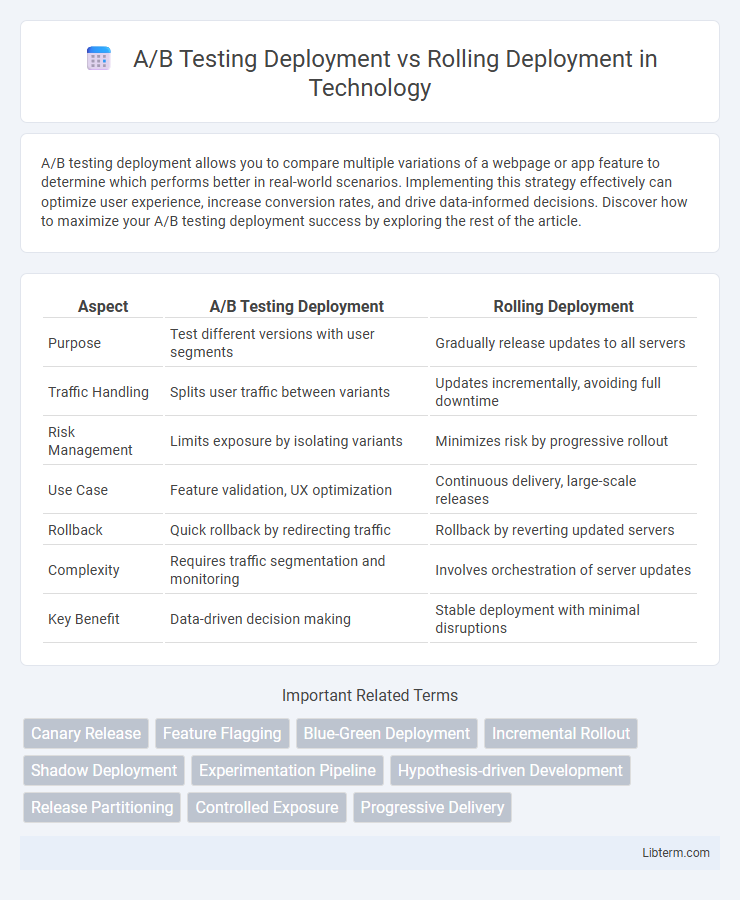A/B testing deployment allows you to compare multiple variations of a webpage or app feature to determine which performs better in real-world scenarios. Implementing this strategy effectively can optimize user experience, increase conversion rates, and drive data-informed decisions. Discover how to maximize your A/B testing deployment success by exploring the rest of the article.
Table of Comparison
| Aspect | A/B Testing Deployment | Rolling Deployment |
|---|---|---|
| Purpose | Test different versions with user segments | Gradually release updates to all servers |
| Traffic Handling | Splits user traffic between variants | Updates incrementally, avoiding full downtime |
| Risk Management | Limits exposure by isolating variants | Minimizes risk by progressive rollout |
| Use Case | Feature validation, UX optimization | Continuous delivery, large-scale releases |
| Rollback | Quick rollback by redirecting traffic | Rollback by reverting updated servers |
| Complexity | Requires traffic segmentation and monitoring | Involves orchestration of server updates |
| Key Benefit | Data-driven decision making | Stable deployment with minimal disruptions |
Introduction to Deployment Strategies
A/B testing deployment divides user traffic between two or more versions to measure performance differences and optimize features, enhancing user experience through data-driven decisions. Rolling deployment gradually updates software by incrementally releasing new versions to small user segments, minimizing downtime and risk while ensuring stability. Both strategies balance release velocity and system reliability depending on organizational goals and user impact tolerance.
Understanding A/B Testing Deployment
A/B testing deployment involves releasing two versions of a software feature simultaneously to different user segments to compare performance metrics and user engagement. This method enables data-driven decisions by isolating variables and observing real-time user behavior without exposing the entire user base to untested changes. Understanding A/B testing deployment is crucial for optimizing user experience and minimizing risks before a full-scale rollout.
What is Rolling Deployment?
Rolling deployment is a software release strategy that incrementally updates application instances across servers or environments without downtime by replacing old versions with new ones in small batches. It ensures continuous service availability and reduces risk by allowing immediate rollback if issues arise during the incremental rollout. Commonly used in cloud-native architectures and containerized environments, rolling deployment supports seamless updates for large-scale distributed systems.
Key Differences Between A/B Testing and Rolling Deployment
A/B testing deployment involves splitting user traffic to compare two or more versions of a feature simultaneously, allowing precise measurement of user behavior and performance metrics. Rolling deployment gradually releases updates to a subset of servers or users over time, prioritizing system stability and minimizing risk without direct comparison of different versions. Key differences lie in A/B testing's focus on controlled experiments for optimization versus rolling deployment's emphasis on incremental release for reliability and seamless update rollout.
Advantages of A/B Testing Deployment
A/B Testing Deployment enables targeted experimentation by directing traffic to distinct versions, allowing precise measurement of user behavior and feature impact. This method reduces risk by isolating changes to a subset of users, preventing widespread potential issues and enabling data-driven decision-making. It enhances product optimization through continuous feedback, increasing user satisfaction and conversion rates based on statistically significant results.
Benefits of Rolling Deployment
Rolling deployment offers continuous delivery benefits by updating applications incrementally across servers, minimizing downtime and reducing risk during the release process. This method enables quick rollback to previous stable versions if issues arise, enhancing system reliability and user experience. It supports seamless scalability and consistent performance, making it ideal for large-scale environments requiring high availability.
Challenges and Risks of Each Deployment Method
A/B testing deployment risks include inconsistent user experiences and data skew due to traffic fragmentation, potentially leading to inaccurate conclusions and biased metrics. Rolling deployment challenges involve gradual exposure to new versions, increasing the risk of widespread outages if errors are detected late in the release process. Both methods require robust monitoring systems to quickly identify and mitigate deployment-related issues while balancing risk with feature delivery speed.
Choosing the Right Deployment Strategy
Choosing the right deployment strategy depends on your application's risk tolerance and user base size. A/B testing deployment allows you to test new features with a subset of users, minimizing risk by comparing performance metrics before a full rollout. Rolling deployment gradually updates servers, reducing downtime and enabling quick rollback, making it ideal for stable environments requiring continuous delivery.
Best Practices for Successful Deployment
A/B Testing Deployment requires clear segmentation of user groups and precise traffic allocation to measure performance differences effectively, ensuring minimal disruption and accurate data collection. Rolling Deployment emphasizes gradual release with continuous monitoring for errors and automated rollback mechanisms to maintain system stability and user experience. Both methods demand thorough pre-deployment testing, real-time analytics, and well-defined rollback strategies to achieve successful, risk-mitigated releases.
Conclusion: A/B Testing Deployment vs Rolling Deployment
A/B Testing Deployment offers precise user experience comparisons by exposing separate user segments to distinct versions, enabling data-driven decisions based on direct feedback. Rolling Deployment gradually releases updates to the entire user base in phases, minimizing risk and allowing rapid rollback if issues arise. For targeted feature validation, A/B Testing excels, while Rolling Deployment is better suited for stable, incremental rollouts demanding broad impact and reduced downtime.
A/B Testing Deployment Infographic

 libterm.com
libterm.com